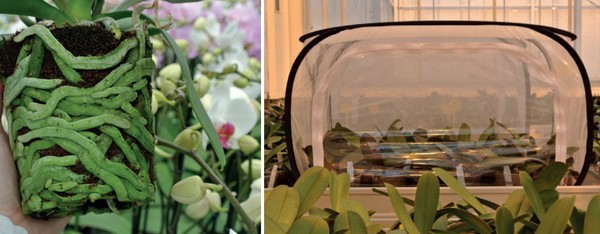An orchid trial with three different substrates has been completed in the innovation centre 'De Kas' of the Van der Knaap Group. During this trial, the substrates were compared for the cultivation of Phalaenopsis in 12 cm pots. Fibre-Neth has proven itself as an alternative substrate: it absorbs water and nutrition quickly and dries evenly. Moreover, because of the structure of the substrate, the larvae of the potworm gnat have no chance to develop.

Left: root development on Fibre-Neth. Right: potworm is introduced in the test.
The experimental design is based on three substrates. The Fibre-Neth substrate based on specially selected coconut substrate, a loose mixture of coconut and bark and, as a reference, the traditional Phalaenopsis substrate based on bark and sphagnum. In total, over 1,600 plants were grown from two different cultivars: 'Red Eye' and 'Sweet Talk' by Floricultura.
Results substrate trial
After a relatively short growing period of 23 weeks, the plants were evaluated to show the differences in growth, development and rooting between the different substrates. With both the loose coconut substrate and the FibreNeth substrate, an accelerated growth was observed. This shows that it is possible to achieve a similar result in fewer growing weeks compared to the current barks substrates. The grower can make the choice to produce a heavier quality in the same number of weeks.
Overall, the Fibre-Neth substrate scored best, says Van der Knaap. In the last counts, the number of plants that developed three branches was particularly high (14.4%) compared to the other two substrates (6.2% in the loose substrate and only 1.4% in the reference substrate).
A detailed discussion of the research results can be read here.
For more information:
Van der Knaap Groep 
+31 174 296606
vdk@vanderknaap.info
www.vanderknaap.info
